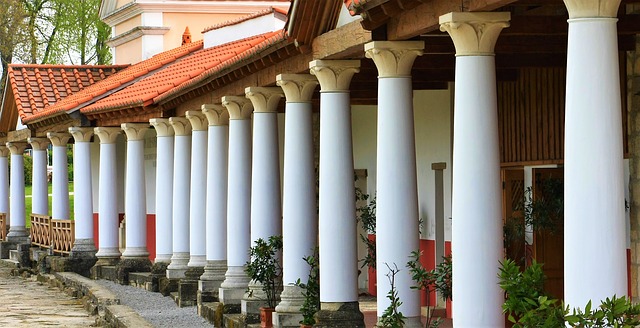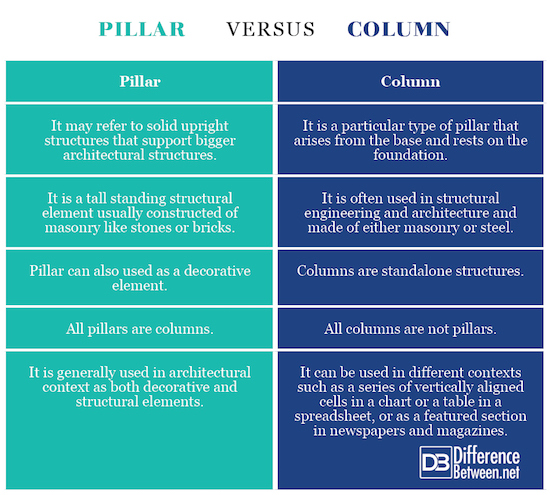Difference Between Pillar and Column
Both the terms pillar and column are often used interchangeably in architectural context to describe a vertical standing structure usually made of stone, metal, or wood. Both are physical structures in cylindrical form and standing upright usually to support a much larger structure above them, such as a horizontal beam or a building. Apart from a common architectural factor, otherwise both can be used in different contexts. One potential difference could be the way they are used in a structure or from an engineering standpoint it all comes down to one thing – nomenclature. While one might think of pillar as a decorative element, others may think of an architectural structure standing upright like a column. Both are almost same but with a few exceptions in terms of functionality.
What is a Pillar?
Pillar is a large solid structure from an engineering standpoint, usually in cylindrical form standing upright or a firm support for another bigger structure such as a building or a monument. A pillar is an essential part of something much bigger usually constructed out of masonry such as concrete, stones or bricks. Pillars are specifically designed to withstand weight like a roof of a building or the upper floors of a building as a supportive structural element. Pillars can also be standalone structures as decorative piece of element such as a commemorative pillar.
What is a Column?
Column is a particular type of pillar with exceptional load-bearing capability, hence stands integral to the structural design of a building. A column plays an integral role in the structural design of a large standing structure, usually with a solid base or foundation and the capital. Unlike a pillar, columns can be constructed of either masonry or stainless steel and can be of many varied shapes such as rectangular, square, circular, hexagonal, octagonal, and more. Apart from the architectural context, the term column may used to refer to a series of vertically placed cells in a chart, table or a spreadsheet. Additionally, they can be used as featured sections or articles in newspaper columns or magazine columns.
Difference between Pillar and Column
-
Meaning of Pillar and Column
Pillar is a structural element in structural engineering and architecture, usually a tall vertical structure standing upright or a firm support for another superstructure. It can be made of stones, bricks, metal, or any other material and can be of any shape. A pillar can be both decorative and functional like a front canopy at the entry of your home with pillars as decorative piece of elements. Column, on the other hand, is purely functional and a particular type of pillar, especially one with an identifiable shaft or base like a roof or a horizontal beam.
-
Architecture of Pillar and Column
In architectural context, a pillar is a strong vertical support element standing upright and constructed usually as a single piece of element such as a stone, concrete, or bricks. A pillar is often used as a supportive element with a certain load-bearing function or as a standalone structural element, relatively slender in proportion relative to its height. All pillars can be called columns but not all columns can be pillars. A column is a vertical structural member of an often bigger structure and serves as a solid foundation of a structure. Columns are generally constructed out of structural steel or masonry.
-
Function of Pillar and Column
The main function of a pillar is to support part of a solid vertical structure such as a building or a monument. It better serves its function as a solid foundation, a prominent support for a much larger structure to ensure stability. It may be constructed of a single piece of element such as a stone or wood or built of several units, such as bricks. It also functions as a standalone decorative element, such as commemorative pillars to honor something much bigger. The main function of a column is to support the weight of the roof or also the top floors, mostly in buildings. A column can also be non-structural.
-
Nomenclature for Pillar and Column
Columns are specifically designed to withstand weight, thus have good compressive strength to support large standing structures. Most classical columns arise from a base and rest on a foundation, usually with standard designs like a colonnade – a row of evenly spaced columns, often free standing or part of a building. Stainless steel columns have exceptionally good compressive strength are mostly used in skyscrapers. Then we have concrete columns, stone columns, or pilotis – support to lift a building above ground, or piers. Pillars, on the other hand, are more like a decorative element like an ornamental structure.
-
Other Meanings for Pillar and Column
A pillar is a particular structure which may also used to refer to a column. The term column, however, can be used in many different contexts to represent a lot of things. A column may refer to a series of vertically represented cells in a chart, table, or a spreadsheet. For example, in Microsoft Excel spreadsheet, we have rows and columns and the function “Excel COLUMN” returns the count of columns of a cell reference. Columns may also refer to certain sections or feature articles written for newspapers, publications, magazines, or newsletters. The term pillar, on the other hand, refers to a structural element that provides support to a bigger structure.
Pillar vs. Column: Comparison Chart
Summary of Pillar Vs. Column
Both pillar and column are the common terms often used in architectural context to describe a tall solid vertical structure standing upright designed usually to provide support to a much larger structure such as a building or a monument. However, the term column can be applied to many different things. A column can be a series of vertically aligned cells in a chart, table, or a spreadsheet, or a body of troops in a military formation. Columns are often used to refer to certain featured sections or articles in newspapers and magazine as newspaper columns or magazine columns.
- Difference Between Caucus and Primary - June 18, 2024
- Difference Between PPO and POS - May 30, 2024
- Difference Between RFID and NFC - May 28, 2024
Search DifferenceBetween.net :
Leave a Response
References :
[0]Image credit: https://www.maxpixel.net/Architecture-Pillar-Arcade-Rome-Building-Roman-3270272
[1]Image credit: https://upload.wikimedia.org/wikipedia/commons/thumb/2/23/Corinthian_column_capitals_-Getty_Villa_-_Outer_Peristyle.jpg/640px-Corinthian_column_capitals_-Getty_Villa_-_Outer_Peristyle.jpg
[2]Clarke, Hewson and John Dougall. The Cabinet of Arts. Toronto, Ontario: ChiZine Publications, 2018. Print
[3]Steiner, Rudolf. Architecture: An Introductory Reader. UK: Rudolf Steiner Press, 2003. Print
[4]Jacques, Heyman. The Science Of Structural Engineering. Singapore: World Scientific, 1999. Print



